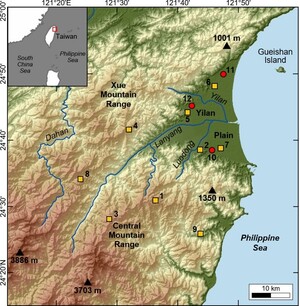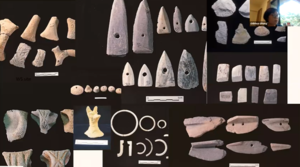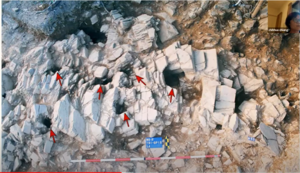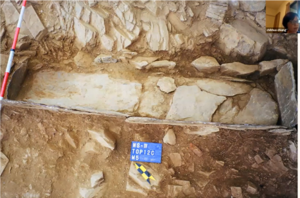The human-environment entanglements in the Late Neolithic Yilan Plain- A case study from the Wansan site, Yilan County




Date :
2022-07-12
Department :
International College of Innovation
【Article by International College of Innovation】
Neolithic people lived at Wansan in Yilan County, Taiwan for over 1,000 years from ca. 2070 to 540 BCE, carving an existence on a hill that was regularly beset by typhoons from the south and torrential monsoon rains from the northeast with its location facing the Pacific Ocean on the east. While they eventually left the area, archeological diggings reveal a rich portmanteau of artifacts which defined their innovations as well as struggles in a hostile physical environment.
This was the gist of the online lecture given by Dr. Chih-hua Chiang, Associate Professor of Archeology at the National Taiwan University on May 11, 2022 for the course Archeology of Taiwan and the Southeast Asian Maritime Worlds. The latter is taught by Dr. Stephen Acabado of the University of California, Los Angeles for the International Program on Austronesian Studies (IPAS). It is followed by masters’ and PhD students from the UCLA, National Chengchi University, Taiwan and Partido State University in the Philippines.
Excavation in the Wansan site was done in 1998 although it was rapid due to budgetary and time constraints hence lacking in flotation and fined-scale digging. Nonetheless, according to Dr. Chiang, they were able to find pits, possibly for storage purposes, and hundreds of artifacts used in tool-making, unfinished tools, working tools, grinding stones, stone coffins and jars used for burial, among others. Stone tools included adzes, flints and knives, ceramic artifacts were primarily jars, various handles and spindle whorls, and there were also ornaments made from nephrite such as bracelets and earrings, probably traded with people from other areas.
Stratigraphy analysis, Bayesian modelling, and radiocarbon dating were deployed to arrive at date estimates and come up with a chronology of human existence on the site. Dr. Chiang found out that the stone-age people used stone tools to actively shape and reshape the hill, carving, modifying, and terracing it to fit their ways of life and secure themselves from the perilous terrain characterized by a sloping, fragile bedrock that is regularly pounded by typhoons and monsoon rains.
In the end, said Dr. Chiang, the modifications done on the hill may have spelled the end of its habitability for the people living there, leading to their exodus. She uses Hodder’s (2016) entanglement hypothesis to frame this millennial event at the Wansan hill where people were stuck in a physical environment requiring innovation and investment in labor to make it habitable. Precarity, however, is path-dependent and could only mean that the settlement had to cease and people had to move out.
Dr. Chiang’s research on the Wansan site has been recently published at the journal Archaeological Research in Asia (Vol. 30, June 2022).
Neolithic people lived at Wansan in Yilan County, Taiwan for over 1,000 years from ca. 2070 to 540 BCE, carving an existence on a hill that was regularly beset by typhoons from the south and torrential monsoon rains from the northeast with its location facing the Pacific Ocean on the east. While they eventually left the area, archeological diggings reveal a rich portmanteau of artifacts which defined their innovations as well as struggles in a hostile physical environment.
This was the gist of the online lecture given by Dr. Chih-hua Chiang, Associate Professor of Archeology at the National Taiwan University on May 11, 2022 for the course Archeology of Taiwan and the Southeast Asian Maritime Worlds. The latter is taught by Dr. Stephen Acabado of the University of California, Los Angeles for the International Program on Austronesian Studies (IPAS). It is followed by masters’ and PhD students from the UCLA, National Chengchi University, Taiwan and Partido State University in the Philippines.
Excavation in the Wansan site was done in 1998 although it was rapid due to budgetary and time constraints hence lacking in flotation and fined-scale digging. Nonetheless, according to Dr. Chiang, they were able to find pits, possibly for storage purposes, and hundreds of artifacts used in tool-making, unfinished tools, working tools, grinding stones, stone coffins and jars used for burial, among others. Stone tools included adzes, flints and knives, ceramic artifacts were primarily jars, various handles and spindle whorls, and there were also ornaments made from nephrite such as bracelets and earrings, probably traded with people from other areas.
Stratigraphy analysis, Bayesian modelling, and radiocarbon dating were deployed to arrive at date estimates and come up with a chronology of human existence on the site. Dr. Chiang found out that the stone-age people used stone tools to actively shape and reshape the hill, carving, modifying, and terracing it to fit their ways of life and secure themselves from the perilous terrain characterized by a sloping, fragile bedrock that is regularly pounded by typhoons and monsoon rains.
In the end, said Dr. Chiang, the modifications done on the hill may have spelled the end of its habitability for the people living there, leading to their exodus. She uses Hodder’s (2016) entanglement hypothesis to frame this millennial event at the Wansan hill where people were stuck in a physical environment requiring innovation and investment in labor to make it habitable. Precarity, however, is path-dependent and could only mean that the settlement had to cease and people had to move out.
Dr. Chiang’s research on the Wansan site has been recently published at the journal Archaeological Research in Asia (Vol. 30, June 2022).
